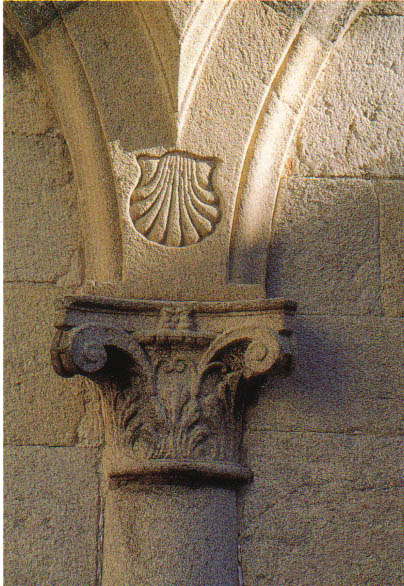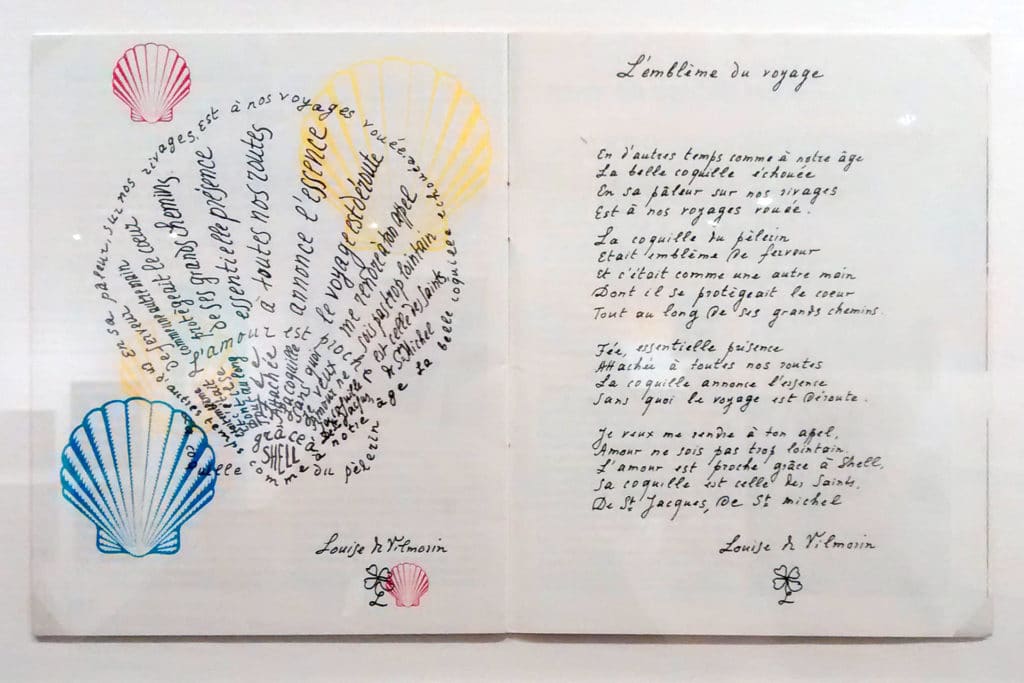La Coquille
In the Middle Ages, pilgrims returning from Compostela wore with joy and pride on their saddlebags, pilgrim’s coats or hats a shell that they had picked up in the Bay of Padron and hung from two holes drilled in the “shell”. This was proof that, after a long and arduous journey, he had indeed completed his pilgrimage to the tomb of the apostle revered in the beautiful city of Santiago.

These large shells, which have given rise to many legends, abounded on the Galician beaches of Padron and Cape Finisterre, often reached as an appendix to the pilgrimage to Santiago de Compostela. In Compostela itself, the pilgrims could also obtain these “signs” – signs or insignia – in their natural state or reproduced in lead. In particular, they were attached to the raised edges of the large hat, to the leather mantelet covering the shoulders, and to the pouch or escarcelle. The shell escutcheon adorning the chimney of one of the old houses in Saint-Léger-lès-Melle (Deux-Sèvres), a former inn on the “chemin de Saint-Jacques ou des pèlerins” to Paris, is the only one we know of where the shells are pierced with two holes. For many, this emblem was a kind of pass to enter Paradise.
Indeed, many pilgrims to Santiago de Compostela were keen to take their shells with them to the grave. During excavations or other works, ancient tombs are sometimes discovered whose origin leaves no doubt: among the bones is the famous shell. In the Drôme, near the remains of a pilgrims’ hospice, the graves of three pilgrims wearing the shell around their necks have been found; in Moissac, in an ancient cemetery, shells have been found with the remains of pilgrims who had completed their return journey at this stopover; Also in Aurillac, during excavations in the church, beautiful shells adorned with decorative lead motifs were found in tombs; in Nice, a shell pierced with four holes to enable it to be attached to a chain was found among the bones under the paving of a chapel. And there are many more places where pilgrims’ graves with shells have been discovered.
Why did Compostela pilgrims wear a shell? We don’t know exactly, but from the outset it was the emblem of the pilgrimage.
Pilgrims returning from Jerusalem bring palms, those returning from Santiago shells. For palms signify triumph and shells good works… These shells are like the fingers of the hand, and the Provençal call them nidules and the French croisilles, and on their return! pilgrims to the shrine of Santiago attach them to their cloaks for the glory of the Apostle… The sort of breastplates with which the mollusk defends itself signify the two precepts of charity with which the wearer must defend himself: to love God above all else and one’s neighbor as oneself.
Codex Calixtinus, book 1

A beautiful legend
The pilgrims of yesteryear, who followed the “starry path” with faith and wonder, were told the following beautiful legend:
“In the time of Blessed Theodemir, bishop of Compostela, a knight was riding along the coast of Galicia. A sea monster attacked his horse and threw him into the sea. Not knowing how to swim and feeling lost, the knight invoked the Apostle Saint James, to whom he had great devotion. Touched by the trust placed in him, Saint James appeared just as the knight was about to be dragged into the waves by the monster. St. James was walking on the water, surrounded by a shimmering light. Around the knight, the water parted in two, revealing the seabed covered in shells. Saint-Jacques gently took the knight in his arms and placed him on a wave that carried him towards the shore. Still in awe, the knight saw the Apostle slowly disappear, still surrounded by light, with shells attached to his garment as an ornament, and then realized that he himself was covered in shells. The knight recounted his miraculous adventure to the pilgrims of Compostela, who saw it as a symbol and immediately adopted the shell as their emblem, giving it the name “coquille Saint-Jacques”.
Originally brought back from the beaches of Galicia, the shell became a sign of rallying and recognition right from the start.
Jeannine Warcollier

